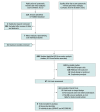Time to Clinical Benefit of Intensive Blood Pressure Lowering in Patients 60 Years and Older With Hypertension: A Secondary Analysis of Randomized Clinical Trials
- PMID: 35532917
- PMCID: PMC9086939
- DOI: 10.1001/jamainternmed.2022.1657
Time to Clinical Benefit of Intensive Blood Pressure Lowering in Patients 60 Years and Older With Hypertension: A Secondary Analysis of Randomized Clinical Trials
Erratum in
-
Error in Key Points.JAMA Intern Med. 2024 May 1;184(5):589. doi: 10.1001/jamainternmed.2022.2852. JAMA Intern Med. 2024. PMID: 35788824 Free PMC article. No abstract available.
Abstract
Importance: Recent guidelines recommend a systolic blood pressure (BP) goal of less than 150 mm Hg or even 130 mm Hg for adults aged 60 years or older. However, harms from intensive BP treatments occur immediately (eg, syncope, fall), and benefits for cardiovascular event reduction emerge over time. Therefore, harms with low chance of benefit need to be clearer, particularly for those with limited life expectancy.
Objective: To estimate the time needed to potentially derive clinical benefit from intensive BP treatment in patients 60 years and older.
Design, setting, and participants: This secondary analysis included individual patient data from published randomized clinical trials with 27 414 patients 60 years or older with hypertension. Patient-level survival data were reconstructed when the original data were not available. Published trials were identified by searching PubMed until October 15, 2021.
Exposures: Intensive BP lowering vs standard BP lowering with the treat-to-target design.
Main outcomes and measures: Major adverse cardiovascular event (MACE) defined by each trial, which was broadly similar with all trials including myocardial infarction, stroke, and cardiovascular mortality.
Results: Six trials (original data from 2 trials and reconstructed data from 4 trials) with 27 414 participants (mean age, 70 years; 56.3% were women) were included in the analysis. Intensive BP treatment with a systolic BP target below 140 mm Hg was significantly associated with a 21% reduction in MACE (hazard ratio, 0.79; 95% CI, 0.71-0.88; P < .001). On average, 9.1 (95% CI, 4.0-20.6) months were needed to prevent 1 MACE per 500 patients with the intensive BP treatment (absolute risk reduction [ARR], 0.002). Likewise, 19.1 (95% CI, 10.9-34.2) and 34.4 (95% CI, 22.7-59.8) months were estimated to avoid 1 MACE per 200 (ARR, 0.005) and 100 (ARR, 0.01) patients, respectively.
Conclusions and relevance: In this analysis, findings suggest that for patients 60 years and older with hypertension, intensive BP treatment may be appropriate for some adults with a life expectancy of greater than 3 years but may not be suitable for those with less than 1 year.
Conflict of interest statement
Figures


Similar articles
-
Blood pressure targets in adults with hypertension.Cochrane Database Syst Rev. 2020 Dec 17;12(12):CD004349. doi: 10.1002/14651858.CD004349.pub3. Cochrane Database Syst Rev. 2020. PMID: 33332584 Free PMC article.
-
Benefit and harm of intensive blood pressure treatment: Derivation and validation of risk models using data from the SPRINT and ACCORD trials.PLoS Med. 2017 Oct 17;14(10):e1002410. doi: 10.1371/journal.pmed.1002410. eCollection 2017 Oct. PLoS Med. 2017. PMID: 29040268 Free PMC article. Clinical Trial.
-
Assessment of Long-term Benefit of Intensive Blood Pressure Control on Residual Life Span: Secondary Analysis of the Systolic Blood Pressure Intervention Trial (SPRINT).JAMA Cardiol. 2020 May 1;5(5):576-581. doi: 10.1001/jamacardio.2019.6192. JAMA Cardiol. 2020. PMID: 32101262 Free PMC article. Clinical Trial.
-
Individualising intensive systolic blood pressure reduction in hypertension using computational trial phenomaps and machine learning: a post-hoc analysis of randomised clinical trials.Lancet Digit Health. 2022 Nov;4(11):e796-e805. doi: 10.1016/S2589-7500(22)00170-4. Lancet Digit Health. 2022. PMID: 36307193 Free PMC article. Clinical Trial.
-
Effects of blood pressure-lowering treatment on cardiovascular outcomes and mortality: 13 - benefits and adverse events in older and younger patients with hypertension: overview, meta-analyses and meta-regression analyses of randomized trials.J Hypertens. 2018 Aug;36(8):1622-1636. doi: 10.1097/HJH.0000000000001787. J Hypertens. 2018. PMID: 29847485 Review.
Cited by
-
The trend of hypertension-related chronic kidney disease from 1990 to 2019 and its predictions over 25 years: an analysis of the Global Burden of Disease Study 2019.Int Urol Nephrol. 2024 Feb;56(2):707-718. doi: 10.1007/s11255-023-03707-w. Epub 2023 Aug 4. Int Urol Nephrol. 2024. PMID: 37542001
-
Effect of Intensive Blood Pressure Control and Comorbidity Status on the Prognosis of Patients With Hypertension: Insights From SPRINT.J Am Heart Assoc. 2025 Mar 18;14(6):e036719. doi: 10.1161/JAHA.124.036719. Epub 2025 Mar 17. J Am Heart Assoc. 2025. PMID: 40094181 Free PMC article. Clinical Trial.
-
Generalisability and potential deaths averted from intensive blood pressure treatment among the elderly population in the US and China: A nationally representative cross-sectional study.J Glob Health. 2023 Sep 8;13:04100. doi: 10.7189/jogh.13.04100. J Glob Health. 2023. PMID: 37681671 Free PMC article.
-
Risk factors of undiagnosed and uncontrolled hypertension in primary care patients with hypertension: a cross-sectional study.BMC Prim Care. 2024 Aug 20;25(1):311. doi: 10.1186/s12875-024-02511-4. BMC Prim Care. 2024. PMID: 39164618 Free PMC article.
-
Metformin use on the risks of depression and anxiety in people with type 2 diabetes.Commun Med (Lond). 2025 Jul 22;5(1):302. doi: 10.1038/s43856-025-01006-2. Commun Med (Lond). 2025. PMID: 40691522 Free PMC article.
References
-
- Blood Pressure Lowering Treatment Trialists’ Collaboration . Age-stratified and blood-pressure-stratified effects of blood-pressure-lowering pharmacotherapy for the prevention of cardiovascular disease and death: an individual participant-level data meta-analysis. Lancet. 2021;398(10305):1053-1064. doi:10.1016/S0140-6736(21)01921-8 - DOI - PMC - PubMed
Publication types
MeSH terms
Substances
LinkOut - more resources
Full Text Sources
Other Literature Sources
Medical

